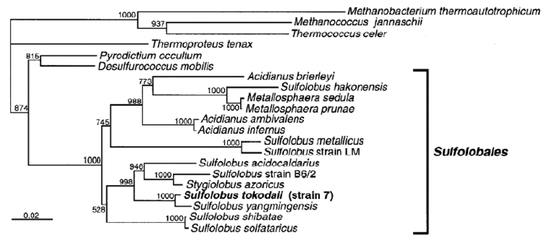
Classification:
Phylogenetic tree for the Sulfolobales. The tree is derived from the multiple nucleotide sequence alignments of the 16S rRNA genes of the representatives of selected archaea including S. tokodaii strain 7 by the neighbor-joining method (2)
Phylogenetic tree for the Sulfolobales. The tree is derived from the multiple nucleotide sequence alignments of the 16S rRNA genes of the representatives of selected archaea including S. tokodaii strain 7 by the neighbor-joining method (2)

Natural History:
pic (4)
Sulpholobus acidocaldarius is an aerobic thermoacidophilic crenarchaeon which grows optimally at 80C and pH 2 in terrestrial solfataric springs (1)
pic (4)
Sulpholobus acidocaldarius is an aerobic thermoacidophilic crenarchaeon which grows optimally at 80C and pH 2 in terrestrial solfataric springs (1)
Habitat (1)
- Primarily aquatic
- Found abundantly in the sulfur-rich hot acid springs in Yellowstone National Park at temperatures between 70-80 C
- Likely to be found in most hot springs but also found in Solfatara soils
- It has temperature sensitive motility that allows it to move away from lethal hot spots
- Occur in great amounts, attached to the surface of sulfur crystals
Metabolism (1)
- Thrives under strictly aerobic conditions on complex organic substrates, including yeast extract, tryptone and Casamino acids, a wide range of amino acids and limited number of sugars (carbon sources)
- Has 3 unique enzymes that allow it to grow on carbon sources
- Oxidizes sulfur to sulfuric acid and contributes to the existence of sulfur-oxidizing bacteria
Reproduction (1)
- Has a short mRNA half-life distribution, similar to those of fast growing bacteria, which meets the need for rapidly reprogramming gene expression upon sudden environmental changes
- Carries a mechanism for UV damage excision repair in its genome (UV damage endonuclease)
Pathology (1)
- Host to lysogenic viruses
- The viruses infect Sulfolobus acidocaldarius to survive in the extremely acidic environment
Conservation Status:
Interesting Facts: (3)
- Grown aerobically and are easy to cultivate in a laboratory scale
- Have developed into a model system for studies of different aspects of microbial adaptation to extreme environments in metabolism, DNA translation and transcription, cell division, and many other cellular aspects
